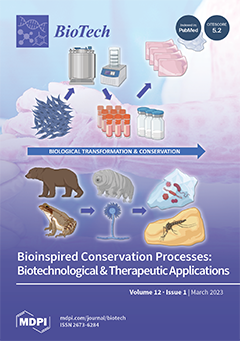The complex evaluation of varietal biochemical differences in rhubarb juice, pomace and roots is highly useful to develop an efficient processing technology. Research was carried out to compare four rhubarb cultivars (Malakhit, Krupnochereshkovy, Upryamets and Zaryanka) in terms of the quality and antioxidant
[...] Read more.
The complex evaluation of varietal biochemical differences in rhubarb juice, pomace and roots is highly useful to develop an efficient processing technology. Research was carried out to compare four rhubarb cultivars (Malakhit, Krupnochereshkovy, Upryamets and Zaryanka) in terms of the quality and antioxidant parameters of juice, pomace and roots. The laboratory analyses showed a high juice yield (75–82%) with a relatively high content of ascorbic acid (125–164 mg L
−1) and other organic acids (16–21 g L
−1). Citric, oxalic and succinic acids accounted for 98% of the total acids amount. The juice of the cultivar Upryamets demonstrated high levels of the natural preservatives sorbic (36.2 mg L
−1) and benzoic acids (11.7 mg L
−1), which are highly valuable in juice production. The juice pomace proved to be an excellent source of pectin and dietary fiber, whose concentrations reached 21–24% and 59–64%, respectively. The total antioxidant activity decreased according to the following sequence: root pulp (161–232 mg GAE g
−1 d.w.) > root peel (115–170 mg GAE g
−1 d.w.) > juice pomace (28.3–34.4 mg GAE g
−1 d.w.) > juice (4.4–7.6 mg GAE g
−1 f.w.), suggesting that root pulp is a highly valuable antioxidant source. The results of this research highlight the interesting prospects of the complex rhubarb plant processing for the production of juice, containing a wide spectrum of organic acids and natural stabilizers (sorbic and benzoic acids), dietary fiber and pectin (juice pomace) and natural antioxidants (roots).
Full article






